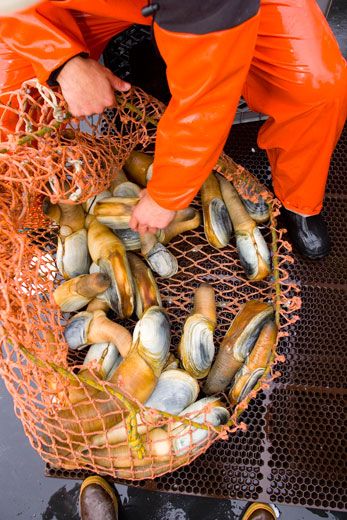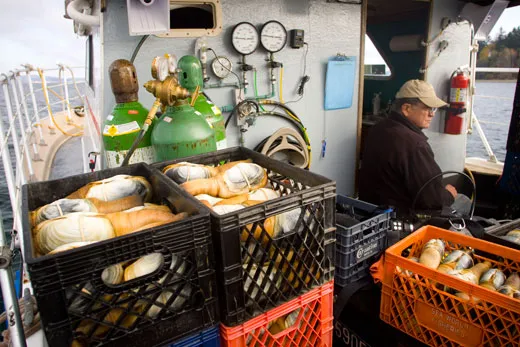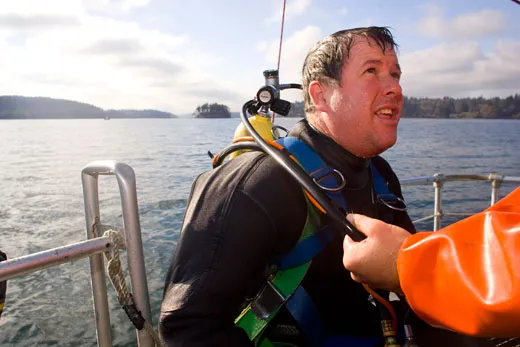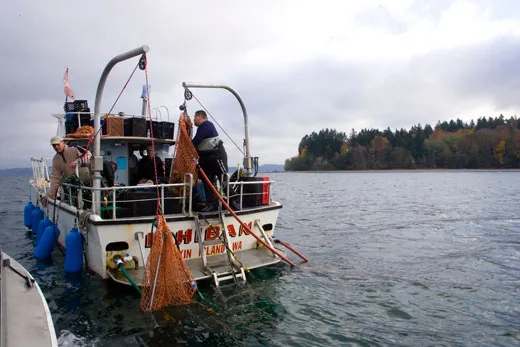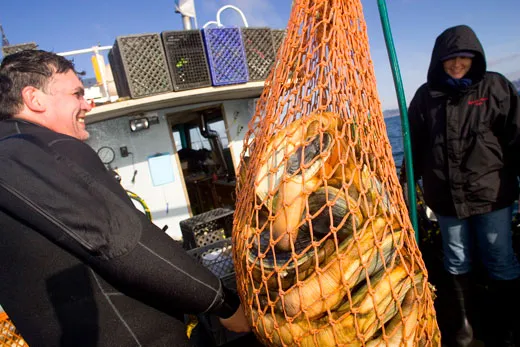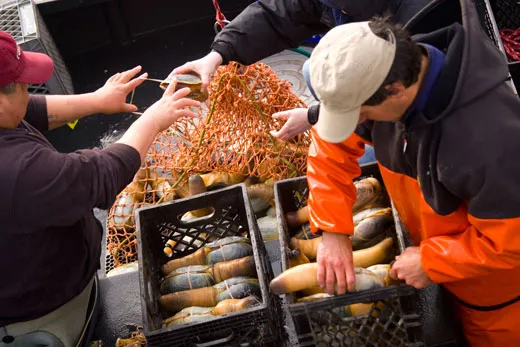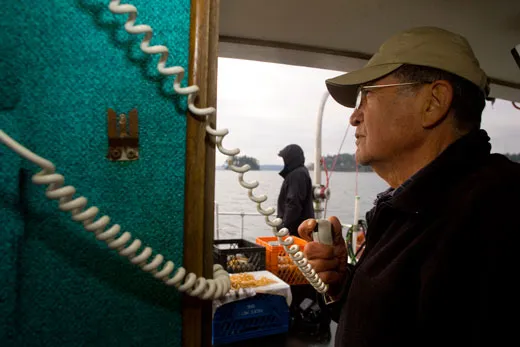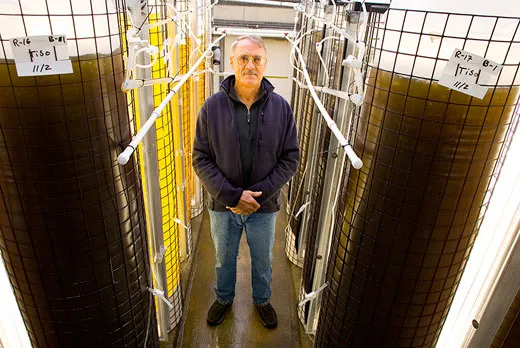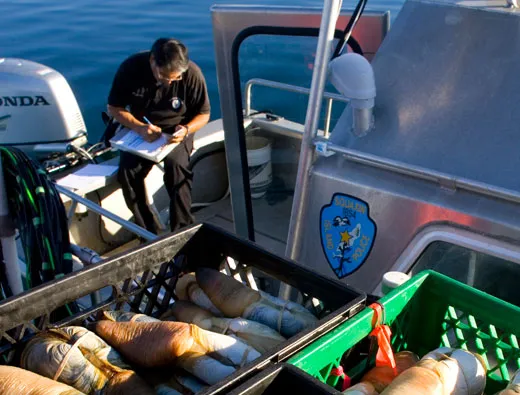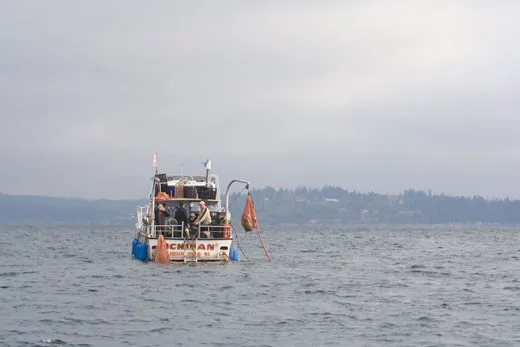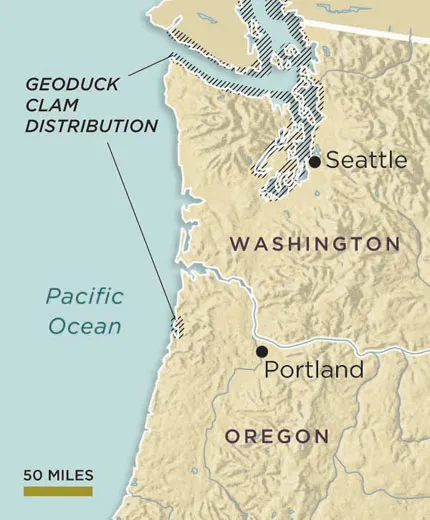Geoducks: Happy as Clams
In the Pacific Northwest, fishermen are cashing in on the growing yen for geoducks, a funny-looking mollusk turned worldwide delicacy
/https://tf-cmsv2-smithsonianmag-media.s3.amazonaws.com/filer/claims-in-net-fishing-geoduck-631.jpg)
Craig Parker popped his head above the surf, peeled off his dive mask and clambered aboard the Ichiban. We were anchored 50 yards offshore from a fir-lined peninsula that juts into Puget Sound. Sixty feet below, where Parker had spent his morning, the seafloor was flat and sandy—barren, to unschooled eyes, except for the odd flounder or orange sea pen. Parker's eyes, though, were well trained. Wearing a neoprene dry suit, he stood in the boat surrounded by the morning's haul: a glistening payload of an absurdly proportioned shellfish defined by a mass of pudgy, lolling flesh.
Buried in the muck beneath Puget Sound lives the Pacific Northwest's most profitable marine creature, a mollusk so valuable that gangsters have traded it for narcotics: the geoduck (pronounced "gooey duck"), the world's largest burrowing clam. Its long, leathery neck can stretch to the length of a baseball bat or recoil to a wrinkled nub. The neck resembles an aardvark's snout, an elephant's trunk or a monstrous prehistoric earthworm emerging from a fist-size shell, among other things.
Forty years ago this mollusk was virtually unknown outside the Northwest. Today Puget Sound fishermen sell four million pounds of it each year, or about two million clams' worth. Swanky New York bistros serve geoduck with rice wine vinegar. Japanese chefs slice it for sushi and sashimi. Most of the harvest goes to China, where cooks in Shanghai and Beijing simmer the clams in hot pots. A single geoduck can fetch $60 in a Hong Kong fish market.
The lowly bivalve, it seems, has come out of its shell. Like many Pacific Northwesterners, I'd long been amused and amazed by the geoduck's rise from obscurity to delicacy. The outsize creature somehow provokes outsize behavior: divers swim among sharks to collect it; scientists labor over burbling caldrons to grow it; detectives track smugglers through night-vision goggles to protect it. So I set out to visit some of those whose lives are linked—by occupation or obsession—to this homely creature. What I found was a universe as unusual as Panopea abrupta itself.
The name geoduck comes from the Nisqually Indian gweduc, which means "dig deep." The clam uses a tiny foot to burrow into the seafloor as it grows. Its shell can end up several feet down, with only its neck poking up into the water. Called siphons, these necks, double-barreled like a shotgun, dimple the sand like rows of wheat. Geoducks feed by drawing microscopic creatures called phytoplankton down one side of the neck, and they expel filtered water through the other. Once buried, a geoduck's shell remains sedentary. While other clams move to avoid predators, a geoduck, when approached by a hungry crab or spiny dogfish, retracts its siphon, like a turtle withdrawing its head.
Geoducks can reach 14 pounds and live more than 150 years—so long that scientists use rings on the clams' shells to track climate change. Geoducks are broadcast spawners: several times a year, in late winter or early spring, males release sperm in smoky clouds, which causes females to release millions of eggs. Within 48 hours, shelled larvae begin swimming; weeks later they drop to the seafloor and start digging. Those landing on rocky bottoms can grow into gnarled clams with dirty gray siphons; those hitting loose sand dig deeper and grow plumper, producing the coveted ivory-colored meat.
Related species grow from Argentina to New Zealand and Japan, but the largest geoducks reside on North America's Pacific Coast. There they support commercial fishing in southeast Alaska, British Columbia and Washington, where the geoduck trade got its start. Hundreds of millions of geoducks inhabit Puget Sound, many of them dwelling in waters hundreds of feet deep. Fishermen collect the clams by hand, by diving to the seafloor trailing breathing tubes. The law restricts divers to waters less than 70 feet deep, mostly for safety reasons: if they went any deeper, they might need to recover inside a decompression chamber.
During Parker's morning dive, in water a chilly 57 degrees Fahrenheit, he had crawled on the seafloor, where anemones glow in waggling fingers of lavender, and pink sea stars shuffle in pursuit of prey. Breathing air through an umbilical linked to a compressor on the boat, Parker scanned the smooth sand for siphon tips. He was armed only with a water spray gun, called a stinger, with which he loosened clams from their beds. In 90 minutes, he had gathered about 150 geoducks.
From a skiff tied alongside the 36-foot Ichiban, I watched with Parker's friend Casey Bakker, a geoduck diver and seafood dealer, as Parker's crew packed the mollusks into plastic crates. Parker and his crew members are all Squaxin Island Indians; Native American tribes hold exclusive treaty rights to half of Puget Sound's commercial shellfish harvests. The clams would be taken to a dock, loaded onto a refrigerated truck, then boxed in ice for shipping. Bakker had arranged for the bivalves to be flown that night, still wriggling, to China.
Geoduck fishing is grueling, even hazardous work. Fishermen drag hundreds of feet of line in a nearly weightless environment, wrestling for leverage and toiling against the tides. A few geoduck divers have been killed on the job. Others have been wrapped around anchors, tangled in gear or swept off by undercurrents. A gray whale's barnacled snout once nosed through the silt and struck Bakker's friend Mark Mikkelsen, flattening him like a whack from a two-by-four. He escaped with a bruise. Bakker once came whisker to whisker with a sea lion. "Down there, a thousand-pound sea lion doesn't look substantially different from a grizzly," he recalled.
Parker recently spied a sixgill shark, and not long before, he confronted a flaming red Pacific octopus (both of these were more thrill than threat). Parker said he struggled for years as a commercial salmon fisherman but started hauling geoducks a decade ago after seeing others profit. "The truth of the matter is, I was scared to death to dive," Parker said. "But these guys were making serious, serious money."
For centuries Native Americans grubbed geoducks from the shallowest parts of their range whenever waters receded far enough. They ate them fresh or smoked. European settlers, too, found geoducks savory. Skillfully cooked, a geoduck would "puzzle persons who tasted it for the first time as to whether they were eating fish, flesh, or fowl," naturalist R.E.C. Stearns wrote in 1882. I found that the clams tasted organic and meaty when baked with mushrooms and onions; served raw they're brackish and chewy like squid, with a faint orange-maple tang.
Geoducks are a source of Pacific Northwest pride, exalted in song ("You can hear the diggers say, as they're headed for the bay, oh I gotta dig a duck, gotta dig a duck a day") and romanticized in novels like David Guterson's Snow Falling on Cedars, in which young Ishmael and Hatsue kiss after a glorious day spent digging the clams. Citing the animal's tendency to stick its neck out, Evergreen State College in Olympia adopted the geoduck as its mascot. The Geoduck Tavern, an aging waterfront bar on the Olympic Peninsula, sponsors a contest during the lowest tide of the year to see which patron can bag the biggest specimen. Gray-haired men sprawl on mud flats, arms buried in tidal sludge. "I dig that dirt out and reach down and reach down, way down, and feel the top of its shell, then take a little hand trawl to break the adhesion, then reach down again and wiggle and wiggle and wiggle until it comes," said Roy Ewen, who has been digging geoducks for 50 years. "It's one of life's real joys."
A Navy diver changed the geoduck's fate in the 1960s, when, searching for lost torpedoes near a submarine base in Puget Sound, he discovered geoduck colonies in the icy deep. The state of Washington auctioned the rights to harvest the clams. Brian Hodgson and a group of hunting buddies borrowed money to lease sections of seabed and started selling geoducks to chowder houses in Washington. With a competitive streak and a head for numbers, Hodgson, a former auditor, quickly became the king of the geoduck trade. A Japanese-American business partner helped him make forays into the Far East in the early 1970s. By the 1980s, Chinese consumers had come to relish the clams. From this indelicate creature, a delicacy was born.
"When you break it down there's a taste with geoduck, a freshness," says Jon Rowley, a seafood marketer who helped popularize Alaska's Copper River salmon. With pollution whittling down shellfish beds in Asia, the freshness itself is a commodity. "That taste is the taste of yesteryear," Rowley adds. Consumers pay more for geoducks, pound for pound, than for Puget Sound salmon or Dungeness crab.
Geoduck fishing is heavily regulated, with harvests strictly limited—a perfect recipe for mischief. Hodgson was accused of stealing a million pounds of clams in the 1980s and eventually pleaded guilty. He had underreported harvests, swiped clams from polluted areas that had been placed off-limits and created a map of closed shellfish beds—the "Poacher's Handbook," he called it—which he gave to his divers.
Washington State's Department of Natural Resources and Department of Fish and Wildlife (WDFW) have clamped down on geoduck crime, and enforcement officers now monitor legal harvests. But poaching and smuggling continue. Bandits falsify records, stash their stolen geoduck contraband in secret compartments in boat hulls, or employ night-vision goggles to grab thousands of geoducks after dark, when clam fishing is illegal. "We've seen tax evasion, extortion, mail fraud, money laundering, people trading clams for Vicodin—you name it," says Lt. Ed Volz, head of special investigations for WDFW. "There's just tremendous money to be made."
Wildlife authorities have stepped up undercover investigations, spying on geoduck thieves from boats (though some poachers use radar to detect vessels trailing them), conducting surveillance from beaches and using underwater cameras to document thefts. In a sting operation a decade ago, one geoduck dealer paid a hit man $5,000 to rough up a rival who was driving up the wages divers earned digging geoducks. The "hit man"—an informant—recorded the transaction for federal agents. The would-be victim was ushered into hiding and the dealer arrested. Today the informant, too, is in prison, convicted in 2003 of masterminding a new smuggling ring that illegally harvested more than $1 million worth of geoducks.
Like a clear-cut forest, heavily fished wild geoduck beds can take decades to regenerate. That's why a biologist named C. Lynn Goodwin helped figure out an alternative.
Inside a beachfront warehouse on Puget Sound's Dabob Bay, Goodwin led me along a sopping floor to the geoduck trade's newest front: a commercial hatchery. Water piped from Puget Sound sprinkled over a basin resembling an enormous birdbath. It was filled with thousands of pebble-size baby geoducks. The shells, smaller than Goodwin's pinkie nail, couldn't contain the clams' girth. "See how they're sticking their necks out? They're feeding," Goodwin said. The tiny siphons stretched skyward, like sparrow chicks craning toward a worm.
Goodwin, who has studied geoducks since 1967 and retired from the state wildlife agency in 1994, remains a clam fanatic. He named his sailboat Panope and his car license plate reads "GEODKR." In the early 1970s, Goodwin became the first person ever to breed geoducks in a laboratory setting—in a five-gallon bucket. "I just wanted to see if it could be done," Goodwin recalled. To study the mollusk's early life stages, he dropped dozens of clams in cold water and fed them for several weeks, then jacked up the water temperature, inducing a few males to release sperm. But his equipment was primitive, his clam food was riddled with bacteria and he couldn't get the larvae to grow reliably. If he could, he reasoned, perhaps the state could someday plant geoduck beds, much like people farm oysters.
At a state research hatchery in the 1980s, Goodwin and his colleagues succeeded in producing baby mollusks. Getting geoducks to grow after the creatures were transplanted was another matter. The researchers planted little geoducks and big ones, tucked them neatly in the sand and dumped them from boats, buried them in deep and shallow water. "We did at least 100 experiments and I think we planted 18 million clams on old, harvested beds," Goodwin said, laughing. Almost every time, the crop died.
Goodwin and I strolled past larvae-rearing tanks as big as brewery boilers. A tang filled the air, the smell of a fetid rain forest on a hot day. Down the hall, water-heater-size plastic bladders bubbled with shellfish feed—algae of varying hues, from mahogany to brilliant green.
By the mid-1990s, other biologists finished the work Goodwin began. They caged the clams in protective plastic cones covered with mesh, allowing the clams to burrow and grow while protected from predators. That practice, along with Goodwin's research, led to operations like this, run by a shellfish company called Taylor Resources, which provides months-old geoducks to clam farms.
Geoduck farmers place starter clams on tidelands leased from private landowners, poking thousands of plastic pipes through the surf like headstones. Acres of mesh netting blanket the operation. After four or five years, farmers, on foot, drag pressure hoses across the mud during low tides and dig out their harvest. Clam farms in Washington now sell nearly a million pounds of geoducks a year.
In traditional fish farms, salmon or cod may be fed pellets and crammed like hogs into net pens, from which diseases may spread to wild fish. But farmed geoducks, once planted, feed and grow naturally. "So far there have been no diseases known that spread from geoduck farms to a natural population," Goodwin told me, though "there may be down the line." Still, some environmentalists and coastal homeowners want to block new farms and have existing ones dismantled. Activists fear that the miles of clam farms now dominating some shallow bays may drive forage fish from Puget Sound's near shore. Residents also worry that the tons of sand turned over by geoduck harvesting smothers eelgrass beds serving as nurseries to young salmon. They complain that the plastic pipes and nets blow ashore in storms. To be sure, the environmental risks remain largely unknown. Scientists are just beginning to study geoduck aquaculture's impact on the Sound.
Some scientists also worry about the risks that farmed geoducks could pose to native populations. Hatchery-raised geoducks may not be as genetically diverse as wild ones, and some experts fear that transplanted geoducks that breed with natives could "change the genetic structure of wild stocks," says Brent Vadopalas, a biologist at the University of Washington. Anything that reduces genetic diversity could make wild populations less able to adapt in response to disease or changes in habitat. Could that alter long-term survival? "It's a legitimate concern," Goodwin concedes.
Today, at 70, Goodwin works as a consultant for another geoduck operation, Seattle Shellfish. He lives a ten-minute drive from Taylor Resources' hatchery, where he still does research in the company's lab. (His most recent study looked at how summer heat altered the burrowing speed of young geoducks.) "You'd think after playing around with the same critter for 40 years we'd know everything there is to know," Goodwin said. "But we've only scratched the surface." Besides, he told me in a whisper, "I think they're beautiful. Most people go ‘Eeeeew!' That's the first reaction you get. But they're absolutely gorgeous animals."
Craig Welch wrote about Northern spotted owls in the January issue. He is working on a book about wildlife thieves.
Natalie Fobes is a photographer and writer based in Seattle.
